University Portfolio Management: A Comparative Analysis
VerifiedAdded on 2022/08/11
|19
|4259
|24
Project
AI Summary
This report presents an in-depth analysis of three distinct investment portfolios, each managed under different styles and strategies. The project involves creating and managing an actively selected portfolio, a randomly selected portfolio, and a passive portfolio, each containing four common equity stocks. The report outlines the investment policy statements for each portfolio, detailing the risk and return objectives, and specific investor profiles. It then delves into the portfolio management styles, comparing active and passive approaches. The stock selection process is explained, including industry analysis and the rationale behind choosing specific stocks for each portfolio. The report evaluates the initial and end values of the portfolios over an eight-week period, comparing their performance. This includes an examination of the returns generated by each portfolio, and the strategies employed. The analysis includes transaction costs and the impact of market conditions, providing a comprehensive overview of portfolio management techniques and their effectiveness.
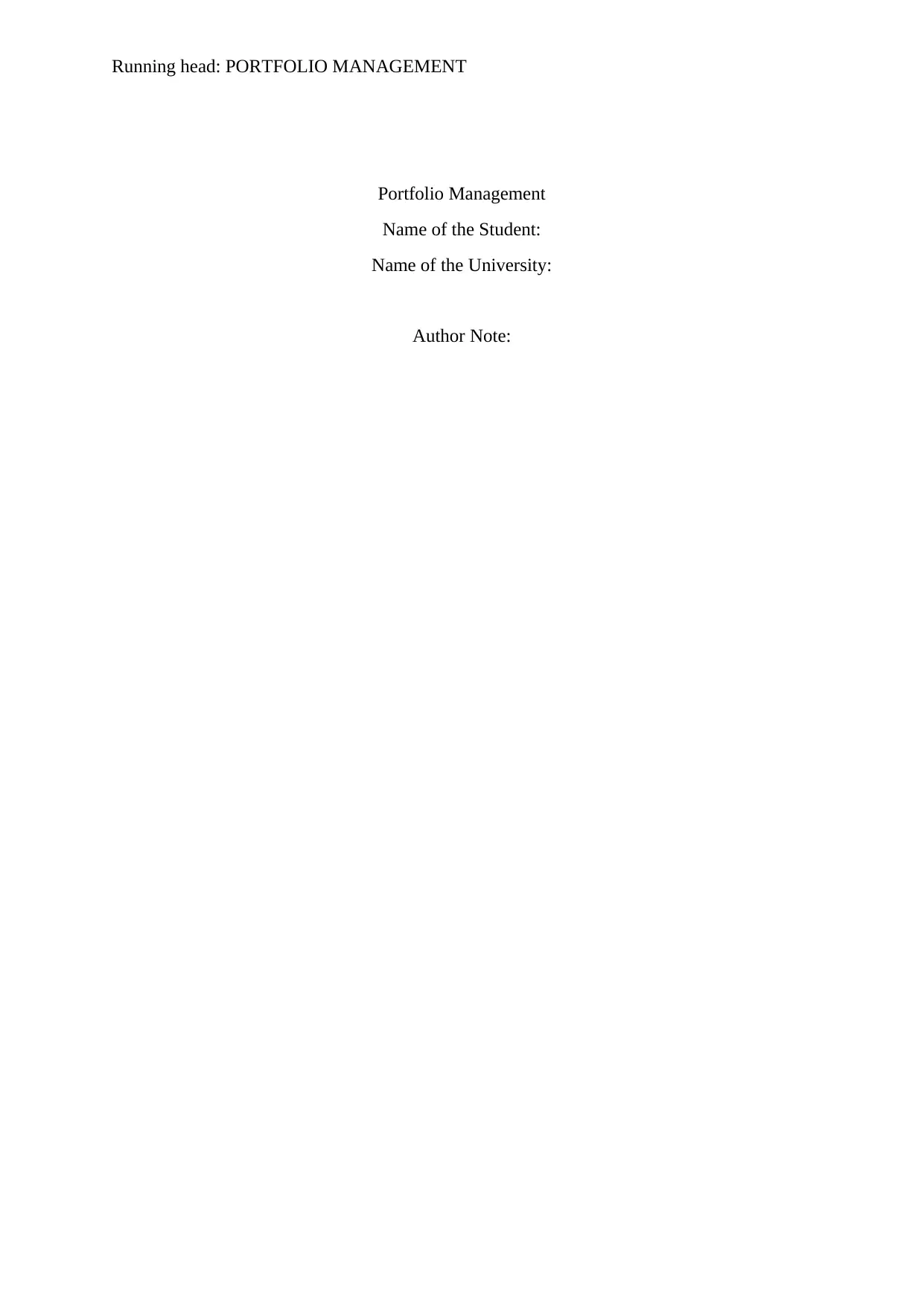
Running head: PORTFOLIO MANAGEMENT
Portfolio Management
Name of the Student:
Name of the University:
Author Note:
Portfolio Management
Name of the Student:
Name of the University:
Author Note:
Paraphrase This Document
Need a fresh take? Get an instant paraphrase of this document with our AI Paraphraser
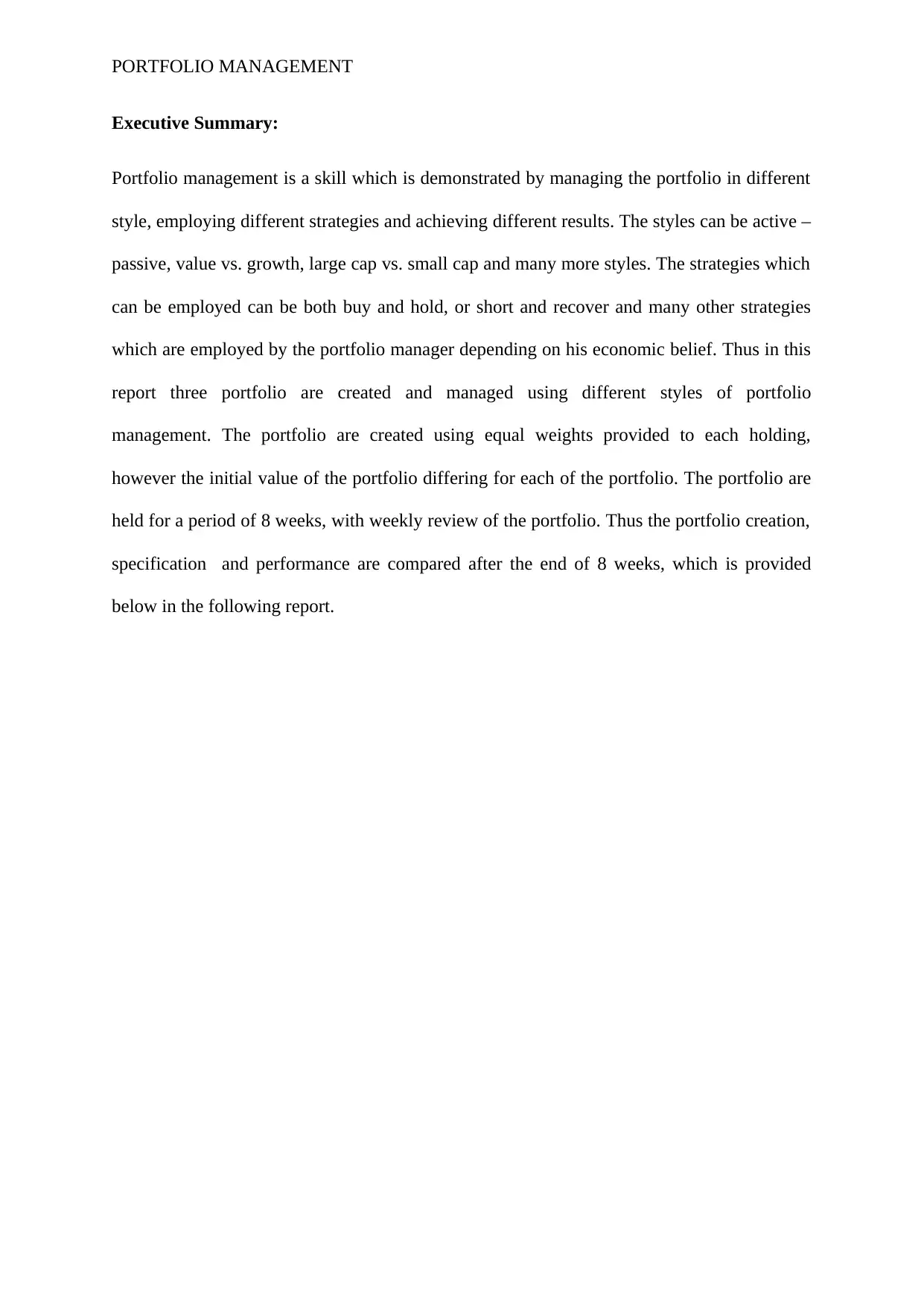
PORTFOLIO MANAGEMENT
Executive Summary:
Portfolio management is a skill which is demonstrated by managing the portfolio in different
style, employing different strategies and achieving different results. The styles can be active –
passive, value vs. growth, large cap vs. small cap and many more styles. The strategies which
can be employed can be both buy and hold, or short and recover and many other strategies
which are employed by the portfolio manager depending on his economic belief. Thus in this
report three portfolio are created and managed using different styles of portfolio
management. The portfolio are created using equal weights provided to each holding,
however the initial value of the portfolio differing for each of the portfolio. The portfolio are
held for a period of 8 weeks, with weekly review of the portfolio. Thus the portfolio creation,
specification and performance are compared after the end of 8 weeks, which is provided
below in the following report.
Executive Summary:
Portfolio management is a skill which is demonstrated by managing the portfolio in different
style, employing different strategies and achieving different results. The styles can be active –
passive, value vs. growth, large cap vs. small cap and many more styles. The strategies which
can be employed can be both buy and hold, or short and recover and many other strategies
which are employed by the portfolio manager depending on his economic belief. Thus in this
report three portfolio are created and managed using different styles of portfolio
management. The portfolio are created using equal weights provided to each holding,
however the initial value of the portfolio differing for each of the portfolio. The portfolio are
held for a period of 8 weeks, with weekly review of the portfolio. Thus the portfolio creation,
specification and performance are compared after the end of 8 weeks, which is provided
below in the following report.
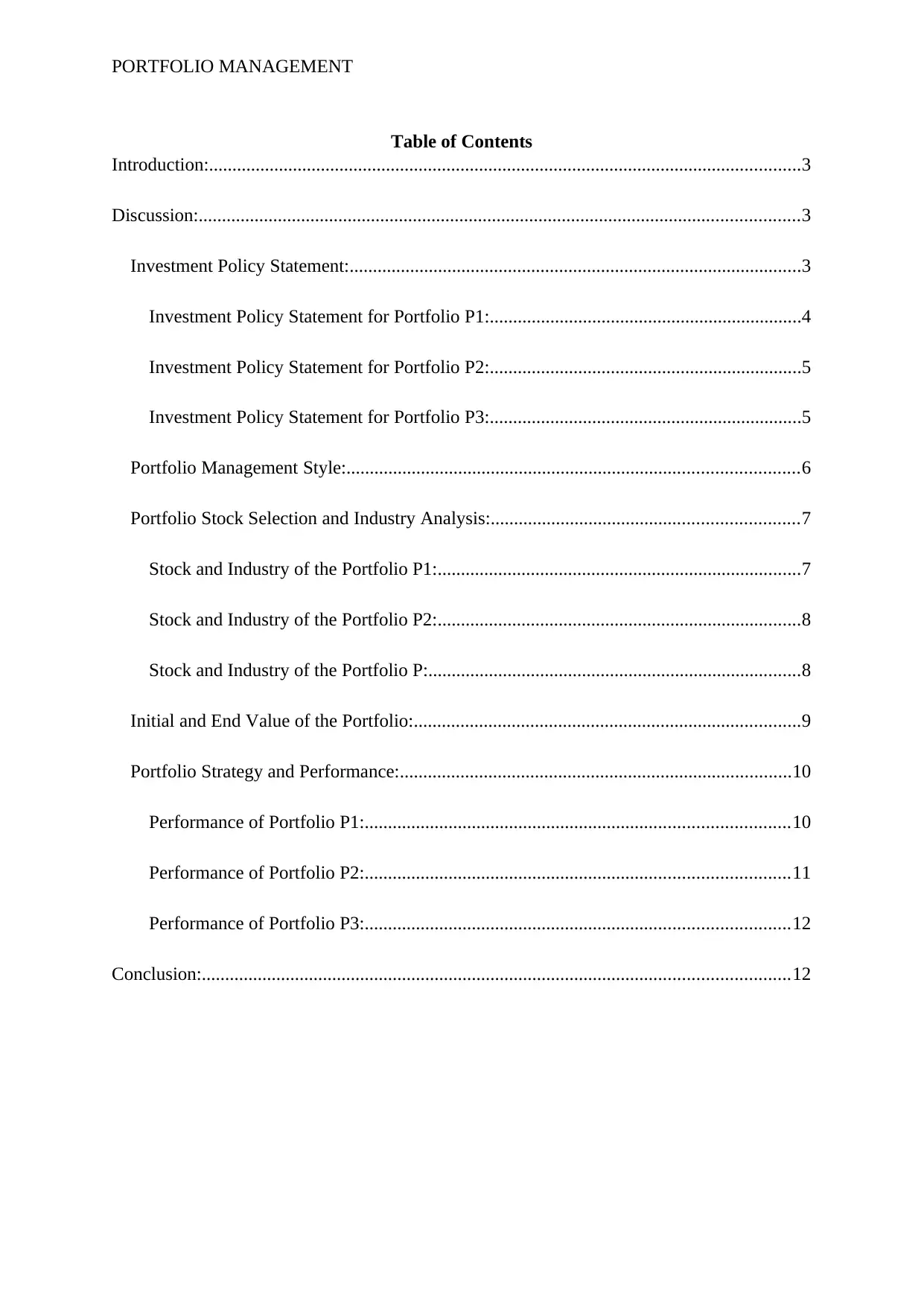
PORTFOLIO MANAGEMENT
Table of Contents
Introduction:...............................................................................................................................3
Discussion:.................................................................................................................................3
Investment Policy Statement:.................................................................................................3
Investment Policy Statement for Portfolio P1:...................................................................4
Investment Policy Statement for Portfolio P2:...................................................................5
Investment Policy Statement for Portfolio P3:...................................................................5
Portfolio Management Style:.................................................................................................6
Portfolio Stock Selection and Industry Analysis:..................................................................7
Stock and Industry of the Portfolio P1:..............................................................................7
Stock and Industry of the Portfolio P2:..............................................................................8
Stock and Industry of the Portfolio P:................................................................................8
Initial and End Value of the Portfolio:...................................................................................9
Portfolio Strategy and Performance:....................................................................................10
Performance of Portfolio P1:...........................................................................................10
Performance of Portfolio P2:...........................................................................................11
Performance of Portfolio P3:...........................................................................................12
Conclusion:..............................................................................................................................12
Table of Contents
Introduction:...............................................................................................................................3
Discussion:.................................................................................................................................3
Investment Policy Statement:.................................................................................................3
Investment Policy Statement for Portfolio P1:...................................................................4
Investment Policy Statement for Portfolio P2:...................................................................5
Investment Policy Statement for Portfolio P3:...................................................................5
Portfolio Management Style:.................................................................................................6
Portfolio Stock Selection and Industry Analysis:..................................................................7
Stock and Industry of the Portfolio P1:..............................................................................7
Stock and Industry of the Portfolio P2:..............................................................................8
Stock and Industry of the Portfolio P:................................................................................8
Initial and End Value of the Portfolio:...................................................................................9
Portfolio Strategy and Performance:....................................................................................10
Performance of Portfolio P1:...........................................................................................10
Performance of Portfolio P2:...........................................................................................11
Performance of Portfolio P3:...........................................................................................12
Conclusion:..............................................................................................................................12
⊘ This is a preview!⊘
Do you want full access?
Subscribe today to unlock all pages.

Trusted by 1+ million students worldwide

PORTFOLIO MANAGEMENT
Introduction:
The following report is the analysis of three portfolio’s consisting of 4 stocks each in
each portfolio. The portfolio management process is a skill which requires the manager to
generate returns which beat the benchmark. However, sometimes in order to generate higher
returns the portfolio is rebalanced frequently, thus leads to an increase in the transaction cost
and taxes. Thus, reducing the returns on the portfolio on an overall basis. Thus the portfolio
which is managed actively by the portfolio manager in order to generate higher returns is
called actively managed portfolio. However, sometimes investors tend to generate returns
which is equal to the index or benchmark return. Thus the portfolio manager need not beat
the benchmark, but generate returns which is equal to the benchmark index or slightly
greater. Thus the manager need not rebalance the portfolio so frequently and hence can be
expected to mimic the benchmark (Buston, 2016).
Thus the aim of this report is to highlight the actions which is taken by an active fund
manager to a passive fund manager. The portfolio will be held for a period of 8 weeks and the
prices of the holding will be recorded on a weekly basis. Thus the returns which is generated
by the three portfolio along with their investment style will be covered in the report.
Discussion:
Investment Policy Statement:
The investment policy statement is a document which is prepared by the portfolio
manager before the starting of the investment. It clarifies all the risk and return objective of
the clients and highlights the special consideration which is pertaining to the client. It defines
the method of execution which can be taken by the portfolio manager when undertaking
investments. It specifies the risk which can be taken by the client with respect to the portfolio,
Introduction:
The following report is the analysis of three portfolio’s consisting of 4 stocks each in
each portfolio. The portfolio management process is a skill which requires the manager to
generate returns which beat the benchmark. However, sometimes in order to generate higher
returns the portfolio is rebalanced frequently, thus leads to an increase in the transaction cost
and taxes. Thus, reducing the returns on the portfolio on an overall basis. Thus the portfolio
which is managed actively by the portfolio manager in order to generate higher returns is
called actively managed portfolio. However, sometimes investors tend to generate returns
which is equal to the index or benchmark return. Thus the portfolio manager need not beat
the benchmark, but generate returns which is equal to the benchmark index or slightly
greater. Thus the manager need not rebalance the portfolio so frequently and hence can be
expected to mimic the benchmark (Buston, 2016).
Thus the aim of this report is to highlight the actions which is taken by an active fund
manager to a passive fund manager. The portfolio will be held for a period of 8 weeks and the
prices of the holding will be recorded on a weekly basis. Thus the returns which is generated
by the three portfolio along with their investment style will be covered in the report.
Discussion:
Investment Policy Statement:
The investment policy statement is a document which is prepared by the portfolio
manager before the starting of the investment. It clarifies all the risk and return objective of
the clients and highlights the special consideration which is pertaining to the client. It defines
the method of execution which can be taken by the portfolio manager when undertaking
investments. It specifies the risk which can be taken by the client with respect to the portfolio,
Paraphrase This Document
Need a fresh take? Get an instant paraphrase of this document with our AI Paraphraser
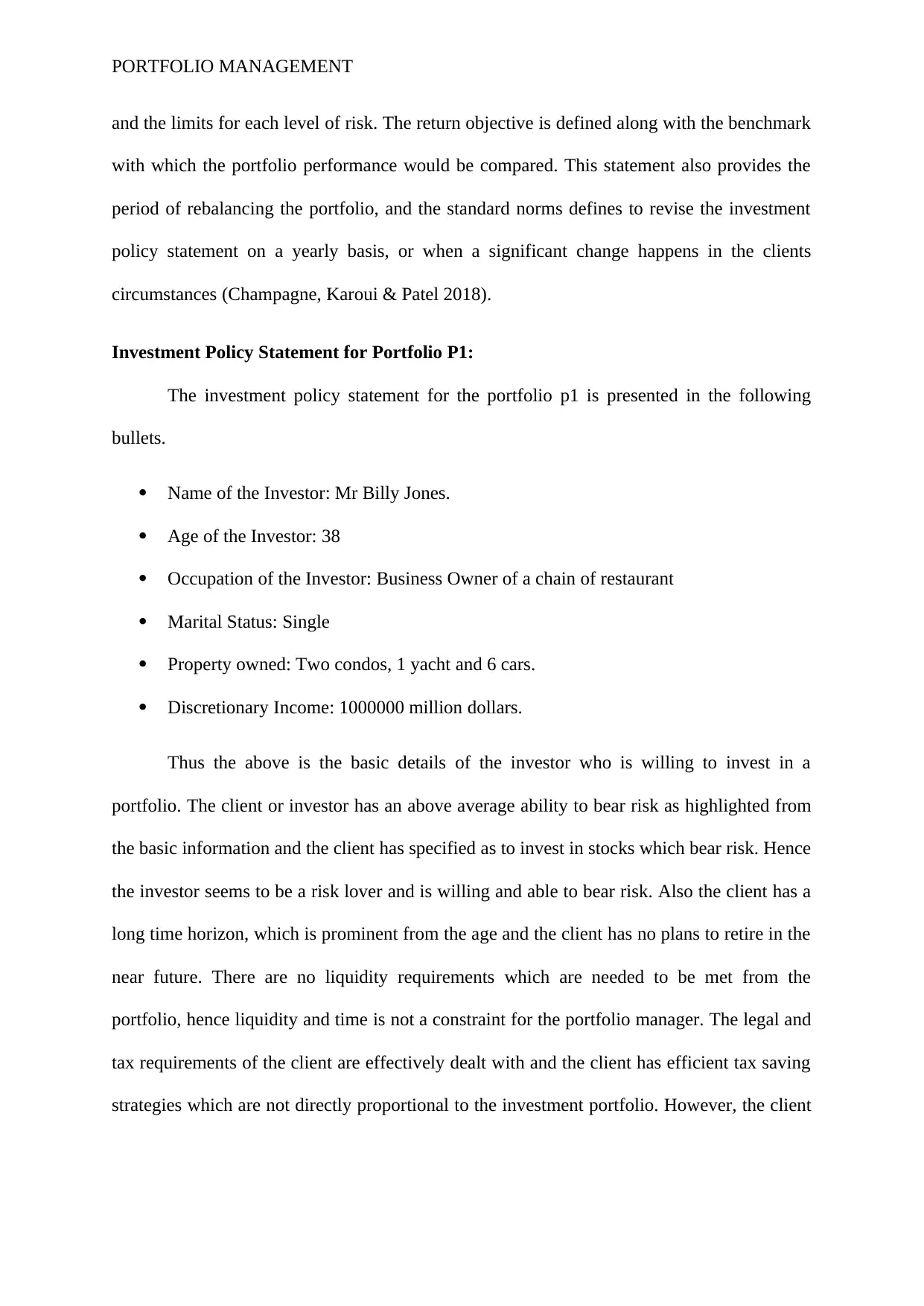
PORTFOLIO MANAGEMENT
and the limits for each level of risk. The return objective is defined along with the benchmark
with which the portfolio performance would be compared. This statement also provides the
period of rebalancing the portfolio, and the standard norms defines to revise the investment
policy statement on a yearly basis, or when a significant change happens in the clients
circumstances (Champagne, Karoui & Patel 2018).
Investment Policy Statement for Portfolio P1:
The investment policy statement for the portfolio p1 is presented in the following
bullets.
Name of the Investor: Mr Billy Jones.
Age of the Investor: 38
Occupation of the Investor: Business Owner of a chain of restaurant
Marital Status: Single
Property owned: Two condos, 1 yacht and 6 cars.
Discretionary Income: 1000000 million dollars.
Thus the above is the basic details of the investor who is willing to invest in a
portfolio. The client or investor has an above average ability to bear risk as highlighted from
the basic information and the client has specified as to invest in stocks which bear risk. Hence
the investor seems to be a risk lover and is willing and able to bear risk. Also the client has a
long time horizon, which is prominent from the age and the client has no plans to retire in the
near future. There are no liquidity requirements which are needed to be met from the
portfolio, hence liquidity and time is not a constraint for the portfolio manager. The legal and
tax requirements of the client are effectively dealt with and the client has efficient tax saving
strategies which are not directly proportional to the investment portfolio. However, the client
and the limits for each level of risk. The return objective is defined along with the benchmark
with which the portfolio performance would be compared. This statement also provides the
period of rebalancing the portfolio, and the standard norms defines to revise the investment
policy statement on a yearly basis, or when a significant change happens in the clients
circumstances (Champagne, Karoui & Patel 2018).
Investment Policy Statement for Portfolio P1:
The investment policy statement for the portfolio p1 is presented in the following
bullets.
Name of the Investor: Mr Billy Jones.
Age of the Investor: 38
Occupation of the Investor: Business Owner of a chain of restaurant
Marital Status: Single
Property owned: Two condos, 1 yacht and 6 cars.
Discretionary Income: 1000000 million dollars.
Thus the above is the basic details of the investor who is willing to invest in a
portfolio. The client or investor has an above average ability to bear risk as highlighted from
the basic information and the client has specified as to invest in stocks which bear risk. Hence
the investor seems to be a risk lover and is willing and able to bear risk. Also the client has a
long time horizon, which is prominent from the age and the client has no plans to retire in the
near future. There are no liquidity requirements which are needed to be met from the
portfolio, hence liquidity and time is not a constraint for the portfolio manager. The legal and
tax requirements of the client are effectively dealt with and the client has efficient tax saving
strategies which are not directly proportional to the investment portfolio. However, the client

PORTFOLIO MANAGEMENT
has a unique circumstance to analyse the performance of the portfolio for two months before
making the decision to invest with the portfolio manager.
Investment Policy Statement for Portfolio P2:
The investment policy statement for the portfolio p1 is presented in the following
bullets.
Name of the Investor: Mr Jack Ryan.
Age of the Investor: 27
Occupation of the Investor: Started his career as a sales manager.
Marital Status: Single
Property owned: Own home with mortgage, one car.
Discretionary Income: 10000 dollars.
The client is a job oriented person who has just started his career as a sales manager,
and is willing to invest and try the luck in the stock markets. The investor has own home with
mortgage while owing a car, thus the ability to take risk is less for the investor. Also the
investor has specified as he no specific risk preference in the management of the portfolio
and is neutral with lower risk or higher risk. Thus the investor can be classified as a risk
neutral investor according to the specific circumstances of the investor. The investor has a
unique circumstance to invest in the markets for 2 months and analyse the performance of the
portfolio and then making a decision to invest in the portfolio for a longer term. The liquidity
requirements for the client are low as the basic expense of the client are met from the salary
of the client. The discretionary income which is available by the client can be used for
making the investment which he has received from his grandmother.
has a unique circumstance to analyse the performance of the portfolio for two months before
making the decision to invest with the portfolio manager.
Investment Policy Statement for Portfolio P2:
The investment policy statement for the portfolio p1 is presented in the following
bullets.
Name of the Investor: Mr Jack Ryan.
Age of the Investor: 27
Occupation of the Investor: Started his career as a sales manager.
Marital Status: Single
Property owned: Own home with mortgage, one car.
Discretionary Income: 10000 dollars.
The client is a job oriented person who has just started his career as a sales manager,
and is willing to invest and try the luck in the stock markets. The investor has own home with
mortgage while owing a car, thus the ability to take risk is less for the investor. Also the
investor has specified as he no specific risk preference in the management of the portfolio
and is neutral with lower risk or higher risk. Thus the investor can be classified as a risk
neutral investor according to the specific circumstances of the investor. The investor has a
unique circumstance to invest in the markets for 2 months and analyse the performance of the
portfolio and then making a decision to invest in the portfolio for a longer term. The liquidity
requirements for the client are low as the basic expense of the client are met from the salary
of the client. The discretionary income which is available by the client can be used for
making the investment which he has received from his grandmother.
⊘ This is a preview!⊘
Do you want full access?
Subscribe today to unlock all pages.

Trusted by 1+ million students worldwide
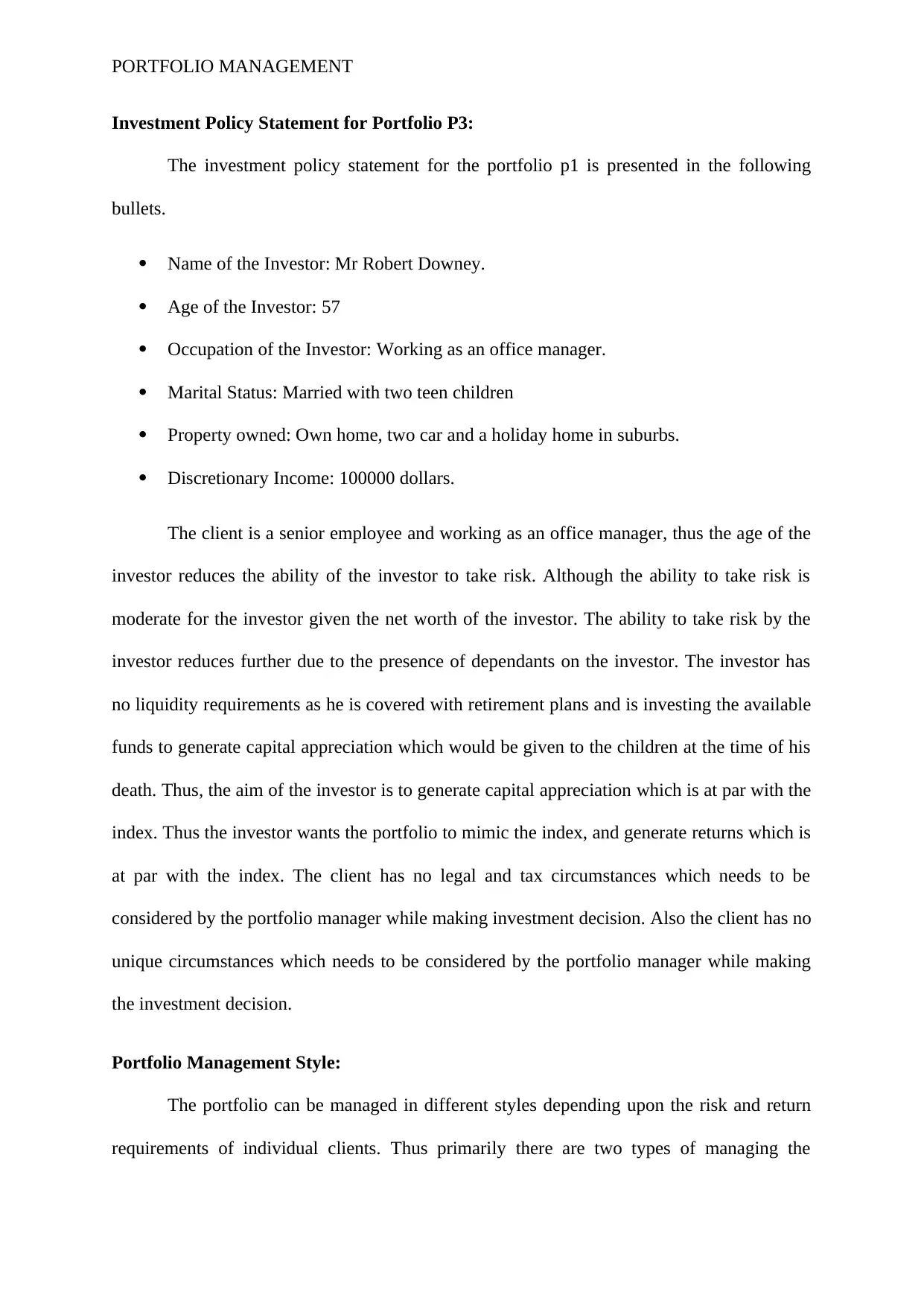
PORTFOLIO MANAGEMENT
Investment Policy Statement for Portfolio P3:
The investment policy statement for the portfolio p1 is presented in the following
bullets.
Name of the Investor: Mr Robert Downey.
Age of the Investor: 57
Occupation of the Investor: Working as an office manager.
Marital Status: Married with two teen children
Property owned: Own home, two car and a holiday home in suburbs.
Discretionary Income: 100000 dollars.
The client is a senior employee and working as an office manager, thus the age of the
investor reduces the ability of the investor to take risk. Although the ability to take risk is
moderate for the investor given the net worth of the investor. The ability to take risk by the
investor reduces further due to the presence of dependants on the investor. The investor has
no liquidity requirements as he is covered with retirement plans and is investing the available
funds to generate capital appreciation which would be given to the children at the time of his
death. Thus, the aim of the investor is to generate capital appreciation which is at par with the
index. Thus the investor wants the portfolio to mimic the index, and generate returns which is
at par with the index. The client has no legal and tax circumstances which needs to be
considered by the portfolio manager while making investment decision. Also the client has no
unique circumstances which needs to be considered by the portfolio manager while making
the investment decision.
Portfolio Management Style:
The portfolio can be managed in different styles depending upon the risk and return
requirements of individual clients. Thus primarily there are two types of managing the
Investment Policy Statement for Portfolio P3:
The investment policy statement for the portfolio p1 is presented in the following
bullets.
Name of the Investor: Mr Robert Downey.
Age of the Investor: 57
Occupation of the Investor: Working as an office manager.
Marital Status: Married with two teen children
Property owned: Own home, two car and a holiday home in suburbs.
Discretionary Income: 100000 dollars.
The client is a senior employee and working as an office manager, thus the age of the
investor reduces the ability of the investor to take risk. Although the ability to take risk is
moderate for the investor given the net worth of the investor. The ability to take risk by the
investor reduces further due to the presence of dependants on the investor. The investor has
no liquidity requirements as he is covered with retirement plans and is investing the available
funds to generate capital appreciation which would be given to the children at the time of his
death. Thus, the aim of the investor is to generate capital appreciation which is at par with the
index. Thus the investor wants the portfolio to mimic the index, and generate returns which is
at par with the index. The client has no legal and tax circumstances which needs to be
considered by the portfolio manager while making investment decision. Also the client has no
unique circumstances which needs to be considered by the portfolio manager while making
the investment decision.
Portfolio Management Style:
The portfolio can be managed in different styles depending upon the risk and return
requirements of individual clients. Thus primarily there are two types of managing the
Paraphrase This Document
Need a fresh take? Get an instant paraphrase of this document with our AI Paraphraser

PORTFOLIO MANAGEMENT
portfolio which are active management and passive management of the portfolio. The active
management of the portfolio involves churning of the portfolio by the portfolio based on its
expectations of the stock. The portfolio manager aims to earn abnormal return and to beat the
benchmark, thus this involves churning of the portfolio. Thus the active management can lead
to the portfolio incurring greater transaction cost which can increase the cost for the investor.
Passive management of the portfolio involves the portfolio manager to invest in stocks and
try to mimic the return which is generated from the index. Thus this management style
involves less churning of the portfolio by the manager which reduces the transaction cost and
taxes for the investor (Chandra, 2017).
Portfolio Stock Selection and Industry Analysis:
The portfolio which have been created have been conducted by an analysis of the
industry and the stock are selected after the analysis. The rationale for taking the stocks in the
portfolio is based on the following points.
Stock and Industry of the Portfolio P1:
The following stocks which have been listed in the bullets have been selected for the
portfolio along with the reasons for selection.
Verizon Communication: The stock is related to the communication and
entertainment industry. The stock has been selected as due to the fear of corona virus
people would tend to communicate more over the phone for personal and business
communication, which can lead to rise in the revenue of the share
(www.theverge.com 2020).
Amazon: The stock provides all products which are required by the consumers, for
daily basis and also provides entertainment services. Thus due to the fear of Corona
Virus, consumers would tend to shop for essentials online and to avoid public
portfolio which are active management and passive management of the portfolio. The active
management of the portfolio involves churning of the portfolio by the portfolio based on its
expectations of the stock. The portfolio manager aims to earn abnormal return and to beat the
benchmark, thus this involves churning of the portfolio. Thus the active management can lead
to the portfolio incurring greater transaction cost which can increase the cost for the investor.
Passive management of the portfolio involves the portfolio manager to invest in stocks and
try to mimic the return which is generated from the index. Thus this management style
involves less churning of the portfolio by the manager which reduces the transaction cost and
taxes for the investor (Chandra, 2017).
Portfolio Stock Selection and Industry Analysis:
The portfolio which have been created have been conducted by an analysis of the
industry and the stock are selected after the analysis. The rationale for taking the stocks in the
portfolio is based on the following points.
Stock and Industry of the Portfolio P1:
The following stocks which have been listed in the bullets have been selected for the
portfolio along with the reasons for selection.
Verizon Communication: The stock is related to the communication and
entertainment industry. The stock has been selected as due to the fear of corona virus
people would tend to communicate more over the phone for personal and business
communication, which can lead to rise in the revenue of the share
(www.theverge.com 2020).
Amazon: The stock provides all products which are required by the consumers, for
daily basis and also provides entertainment services. Thus due to the fear of Corona
Virus, consumers would tend to shop for essentials online and to avoid public
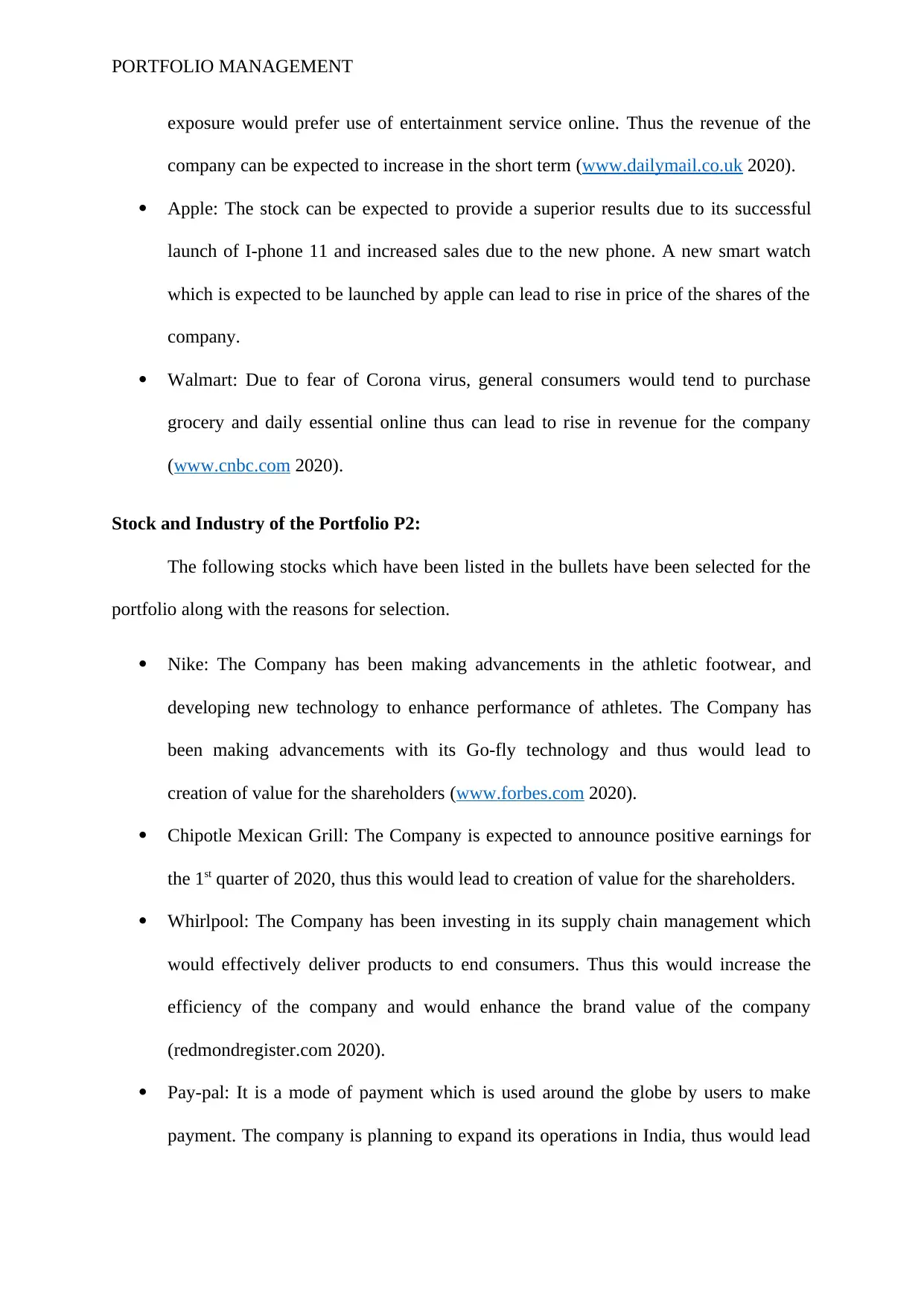
PORTFOLIO MANAGEMENT
exposure would prefer use of entertainment service online. Thus the revenue of the
company can be expected to increase in the short term (www.dailymail.co.uk 2020).
Apple: The stock can be expected to provide a superior results due to its successful
launch of I-phone 11 and increased sales due to the new phone. A new smart watch
which is expected to be launched by apple can lead to rise in price of the shares of the
company.
Walmart: Due to fear of Corona virus, general consumers would tend to purchase
grocery and daily essential online thus can lead to rise in revenue for the company
(www.cnbc.com 2020).
Stock and Industry of the Portfolio P2:
The following stocks which have been listed in the bullets have been selected for the
portfolio along with the reasons for selection.
Nike: The Company has been making advancements in the athletic footwear, and
developing new technology to enhance performance of athletes. The Company has
been making advancements with its Go-fly technology and thus would lead to
creation of value for the shareholders (www.forbes.com 2020).
Chipotle Mexican Grill: The Company is expected to announce positive earnings for
the 1st quarter of 2020, thus this would lead to creation of value for the shareholders.
Whirlpool: The Company has been investing in its supply chain management which
would effectively deliver products to end consumers. Thus this would increase the
efficiency of the company and would enhance the brand value of the company
(redmondregister.com 2020).
Pay-pal: It is a mode of payment which is used around the globe by users to make
payment. The company is planning to expand its operations in India, thus would lead
exposure would prefer use of entertainment service online. Thus the revenue of the
company can be expected to increase in the short term (www.dailymail.co.uk 2020).
Apple: The stock can be expected to provide a superior results due to its successful
launch of I-phone 11 and increased sales due to the new phone. A new smart watch
which is expected to be launched by apple can lead to rise in price of the shares of the
company.
Walmart: Due to fear of Corona virus, general consumers would tend to purchase
grocery and daily essential online thus can lead to rise in revenue for the company
(www.cnbc.com 2020).
Stock and Industry of the Portfolio P2:
The following stocks which have been listed in the bullets have been selected for the
portfolio along with the reasons for selection.
Nike: The Company has been making advancements in the athletic footwear, and
developing new technology to enhance performance of athletes. The Company has
been making advancements with its Go-fly technology and thus would lead to
creation of value for the shareholders (www.forbes.com 2020).
Chipotle Mexican Grill: The Company is expected to announce positive earnings for
the 1st quarter of 2020, thus this would lead to creation of value for the shareholders.
Whirlpool: The Company has been investing in its supply chain management which
would effectively deliver products to end consumers. Thus this would increase the
efficiency of the company and would enhance the brand value of the company
(redmondregister.com 2020).
Pay-pal: It is a mode of payment which is used around the globe by users to make
payment. The company is planning to expand its operations in India, thus would lead
⊘ This is a preview!⊘
Do you want full access?
Subscribe today to unlock all pages.

Trusted by 1+ million students worldwide
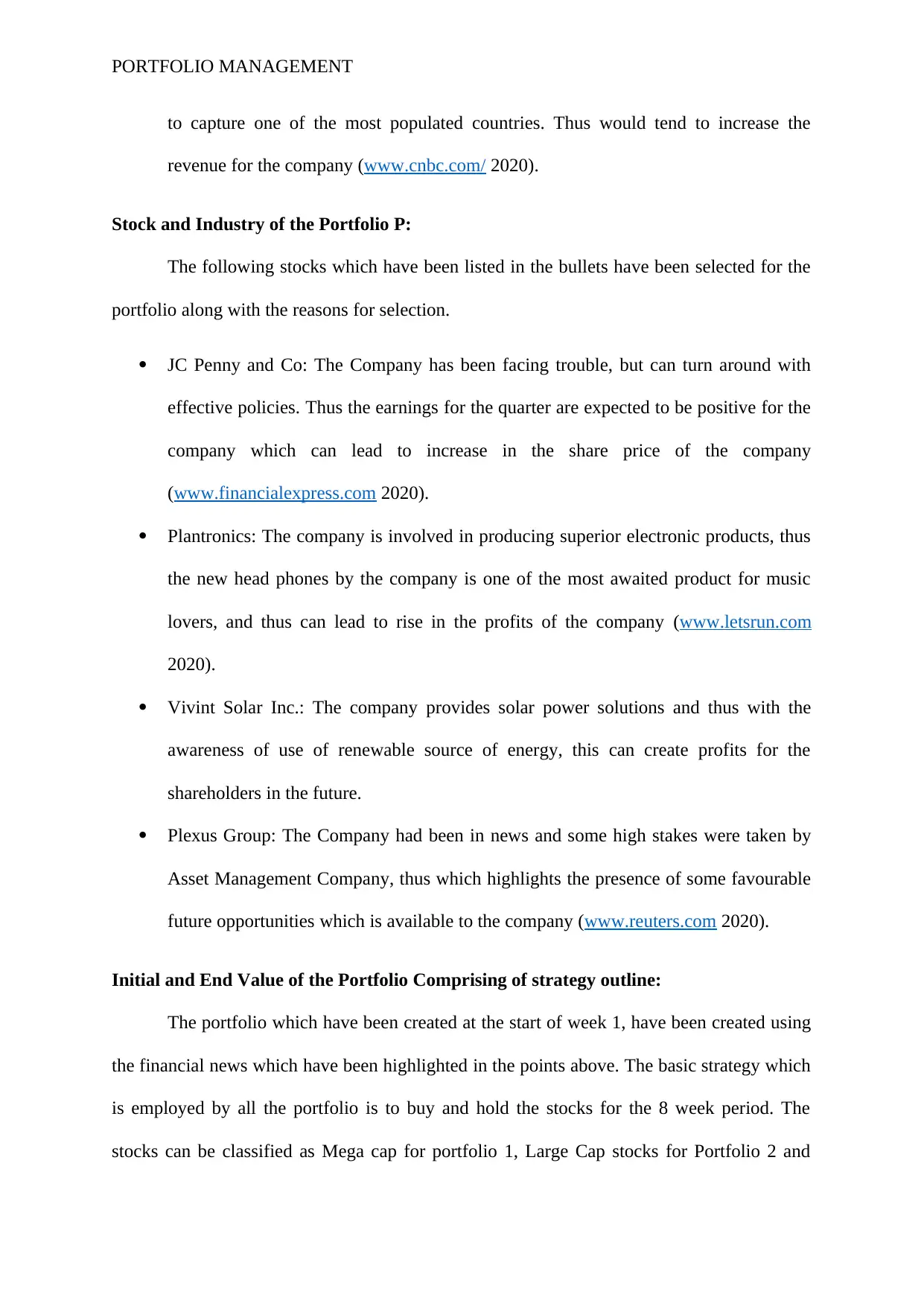
PORTFOLIO MANAGEMENT
to capture one of the most populated countries. Thus would tend to increase the
revenue for the company (www.cnbc.com/ 2020).
Stock and Industry of the Portfolio P:
The following stocks which have been listed in the bullets have been selected for the
portfolio along with the reasons for selection.
JC Penny and Co: The Company has been facing trouble, but can turn around with
effective policies. Thus the earnings for the quarter are expected to be positive for the
company which can lead to increase in the share price of the company
(www.financialexpress.com 2020).
Plantronics: The company is involved in producing superior electronic products, thus
the new head phones by the company is one of the most awaited product for music
lovers, and thus can lead to rise in the profits of the company (www.letsrun.com
2020).
Vivint Solar Inc.: The company provides solar power solutions and thus with the
awareness of use of renewable source of energy, this can create profits for the
shareholders in the future.
Plexus Group: The Company had been in news and some high stakes were taken by
Asset Management Company, thus which highlights the presence of some favourable
future opportunities which is available to the company (www.reuters.com 2020).
Initial and End Value of the Portfolio Comprising of strategy outline:
The portfolio which have been created at the start of week 1, have been created using
the financial news which have been highlighted in the points above. The basic strategy which
is employed by all the portfolio is to buy and hold the stocks for the 8 week period. The
stocks can be classified as Mega cap for portfolio 1, Large Cap stocks for Portfolio 2 and
to capture one of the most populated countries. Thus would tend to increase the
revenue for the company (www.cnbc.com/ 2020).
Stock and Industry of the Portfolio P:
The following stocks which have been listed in the bullets have been selected for the
portfolio along with the reasons for selection.
JC Penny and Co: The Company has been facing trouble, but can turn around with
effective policies. Thus the earnings for the quarter are expected to be positive for the
company which can lead to increase in the share price of the company
(www.financialexpress.com 2020).
Plantronics: The company is involved in producing superior electronic products, thus
the new head phones by the company is one of the most awaited product for music
lovers, and thus can lead to rise in the profits of the company (www.letsrun.com
2020).
Vivint Solar Inc.: The company provides solar power solutions and thus with the
awareness of use of renewable source of energy, this can create profits for the
shareholders in the future.
Plexus Group: The Company had been in news and some high stakes were taken by
Asset Management Company, thus which highlights the presence of some favourable
future opportunities which is available to the company (www.reuters.com 2020).
Initial and End Value of the Portfolio Comprising of strategy outline:
The portfolio which have been created at the start of week 1, have been created using
the financial news which have been highlighted in the points above. The basic strategy which
is employed by all the portfolio is to buy and hold the stocks for the 8 week period. The
stocks can be classified as Mega cap for portfolio 1, Large Cap stocks for Portfolio 2 and
Paraphrase This Document
Need a fresh take? Get an instant paraphrase of this document with our AI Paraphraser

PORTFOLIO MANAGEMENT
small cap stocks for Portfolio 3. Hence the basis for selection of the stock can also be
highlighted by the market capitalization of each stock in the portfolio.
Thus one of the key aspects which is observed by the investor is how much value is created
by the portfolio after the end of the investment period. This is measured in absolute terms for
all the three portfolio in dollar terms. Thus the details for the same is provided in the table
below,
Portfolio Initial Value End Value
Portfolio 1 $236008 $236413
Portfolio 2 $125195 $104345
Portfolio 3 $12112 $8752.5
Thus upon analysing the portfolio, it is seen that only portfolio 1 which is actively
managed portfolio has been able to generate slight return over the initial value invested. The
rest of the two portfolio have led to loss in the capital invested by the investor in absolute
dollar terms (Chaudhuri & Lo 2016).
Portfolio Strategy and Performance:
The creation of the portfolio is one of the most crucial step, which is followed by
measuring the performance of the portfolio. The portfolio tend to meet the objective for
which it had been created which is measured by various performance metrics. Thus the
performance of the portfolio informs the investor the skill which has been provided by the
portfolio manager (Ding & Martin 2017).
Performance of Portfolio P1:
The portfolio performance on a standalone weekly basis along with the three
benchmark index is highlighted in the figure below,
small cap stocks for Portfolio 3. Hence the basis for selection of the stock can also be
highlighted by the market capitalization of each stock in the portfolio.
Thus one of the key aspects which is observed by the investor is how much value is created
by the portfolio after the end of the investment period. This is measured in absolute terms for
all the three portfolio in dollar terms. Thus the details for the same is provided in the table
below,
Portfolio Initial Value End Value
Portfolio 1 $236008 $236413
Portfolio 2 $125195 $104345
Portfolio 3 $12112 $8752.5
Thus upon analysing the portfolio, it is seen that only portfolio 1 which is actively
managed portfolio has been able to generate slight return over the initial value invested. The
rest of the two portfolio have led to loss in the capital invested by the investor in absolute
dollar terms (Chaudhuri & Lo 2016).
Portfolio Strategy and Performance:
The creation of the portfolio is one of the most crucial step, which is followed by
measuring the performance of the portfolio. The portfolio tend to meet the objective for
which it had been created which is measured by various performance metrics. Thus the
performance of the portfolio informs the investor the skill which has been provided by the
portfolio manager (Ding & Martin 2017).
Performance of Portfolio P1:
The portfolio performance on a standalone weekly basis along with the three
benchmark index is highlighted in the figure below,
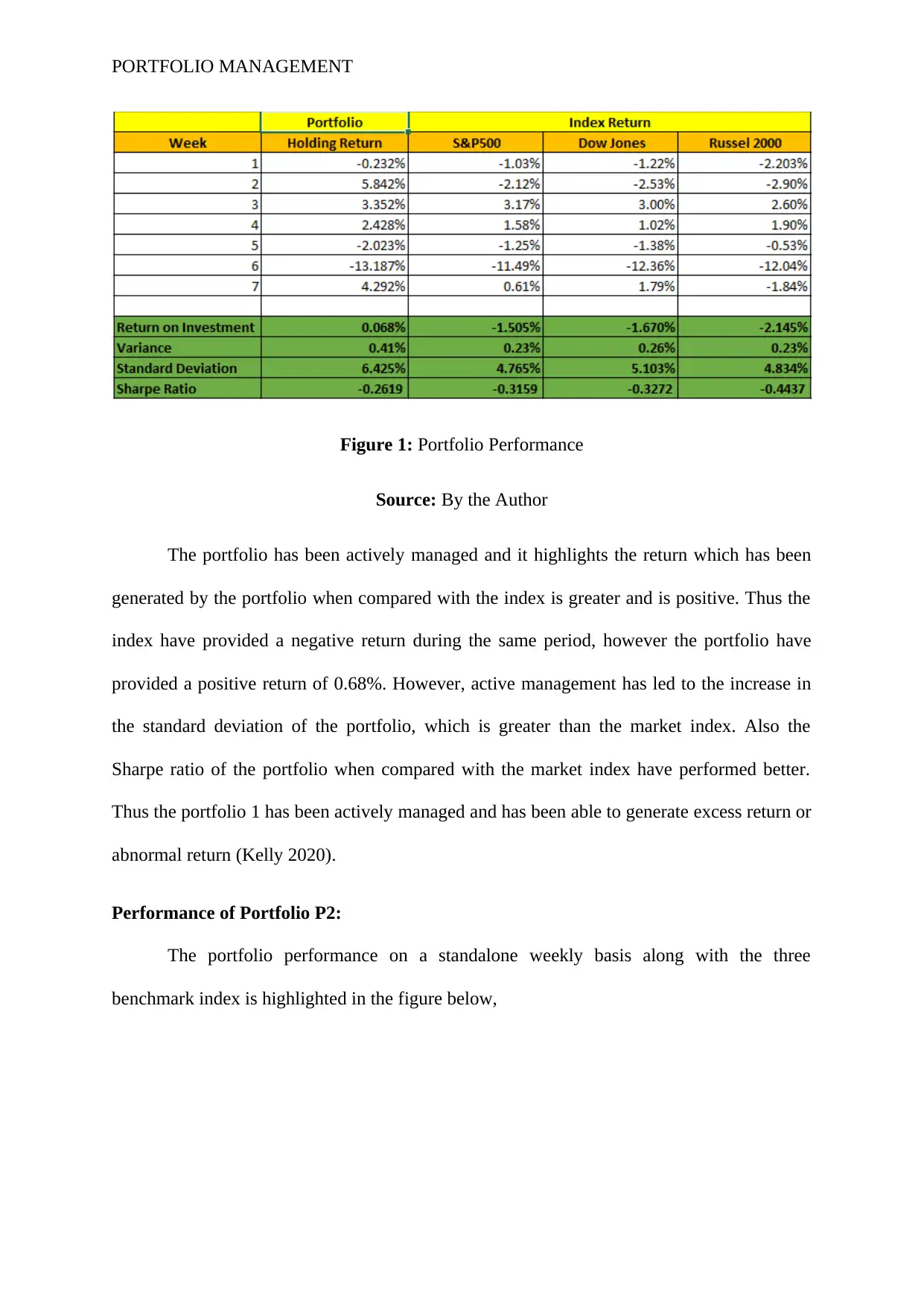
PORTFOLIO MANAGEMENT
Figure 1: Portfolio Performance
Source: By the Author
The portfolio has been actively managed and it highlights the return which has been
generated by the portfolio when compared with the index is greater and is positive. Thus the
index have provided a negative return during the same period, however the portfolio have
provided a positive return of 0.68%. However, active management has led to the increase in
the standard deviation of the portfolio, which is greater than the market index. Also the
Sharpe ratio of the portfolio when compared with the market index have performed better.
Thus the portfolio 1 has been actively managed and has been able to generate excess return or
abnormal return (Kelly 2020).
Performance of Portfolio P2:
The portfolio performance on a standalone weekly basis along with the three
benchmark index is highlighted in the figure below,
Figure 1: Portfolio Performance
Source: By the Author
The portfolio has been actively managed and it highlights the return which has been
generated by the portfolio when compared with the index is greater and is positive. Thus the
index have provided a negative return during the same period, however the portfolio have
provided a positive return of 0.68%. However, active management has led to the increase in
the standard deviation of the portfolio, which is greater than the market index. Also the
Sharpe ratio of the portfolio when compared with the market index have performed better.
Thus the portfolio 1 has been actively managed and has been able to generate excess return or
abnormal return (Kelly 2020).
Performance of Portfolio P2:
The portfolio performance on a standalone weekly basis along with the three
benchmark index is highlighted in the figure below,
⊘ This is a preview!⊘
Do you want full access?
Subscribe today to unlock all pages.

Trusted by 1+ million students worldwide
1 out of 19
Related Documents
Your All-in-One AI-Powered Toolkit for Academic Success.
+13062052269
info@desklib.com
Available 24*7 on WhatsApp / Email
![[object Object]](/_next/static/media/star-bottom.7253800d.svg)
Unlock your academic potential
Copyright © 2020–2025 A2Z Services. All Rights Reserved. Developed and managed by ZUCOL.





